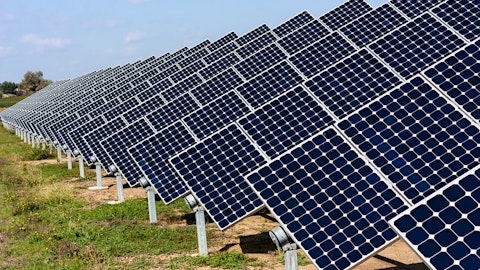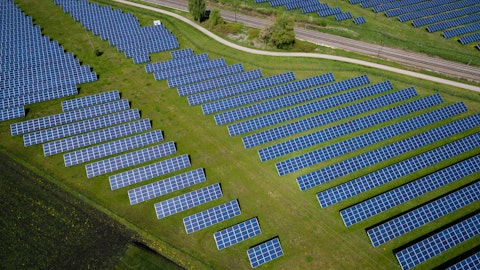Sunnova Energy International Inc. (NYSE:NOVA) Q3 2023 Earnings Call Transcript October 26, 2023
Operator: Good morning and welcome to Sunnova’s Third Quarter 2023 Earnings Conference Call. Today’s call is being recorded and we have allocated an hour for prepared remarks and question and answer. At this time, I would like to turn the conference over to Rodney McMahan, Vice President, Investor Relations at Sunnova. Thank you. Please go ahead.
Rodney McMahan: Thank you, operator. Before we begin, please note during today’s call we will make forward-looking statements that are subject to various risks and uncertainties that are described in our slide presentation, earnings press release, and our 2022 Form 10-K. Please see those documents for additional information regarding those factors that may affect these forward-looking statements. Also, we will reference certain non-GAAP measures during today’s call. Please refer to the appendix of our presentation as well as the earnings press release for the appropriate GAAP to non-GAAP reconciliations and cautionary disclosures. On the call today are John Berger, Sunnova’s Chairman and Chief Executive Officer; and Robert Lane, Executive Vice President and Chief Financial Officer. I will now turn the call over to John.

An industrial engineer standing in front of a factory installation of solar energy panels.
John Berger: Good morning and thank you for joining us. Sunnova remains resilient despite the challenging market dynamics marked by higher interest rates and concerns about overall residential solar growth. Our commitment to develop a sustainable, profitable platform has positioned Sunnova for long-term success in the face of significant macroeconomic challenges, as evidenced by increases to our fully burdened unlevered return as we continue to add new customers. Through our adaptive energy platform, we continue to provide our customers with a better energy service at a better price, ensuring system performance and optimized power generation and economics. The steady robust demand for our distinct suite of energy service offerings, coupled with our dealer network and our increasing market share, have been instrumental in achieving this performance.
Sunnova is focused on liquidity, profitability, and cash flow. We continue to act on these focus areas by raising price, reducing working capital needs, and reducing operating expenses. First, our focus on profitability has pushed up our returns to 12% for the third quarter, allowing us to achieve a healthy implied spread even in this higher interest rate environment, and we are expecting to push past 13% during the fourth quarter. Sunnova’s ability to continually increase prices while maintaining its growth is a testament to the value we bring to our customers and the strength of our offerings. By methodically raising prices, we aim to ensure that our returns are in alignment with the current cost of capital. This move is not only a boost for profitability but also underscores our commitment to enhancing shareholder value.
Second, we are committed to reducing working capital, both used and outstanding, to our valued dealers and equipment manufacturing partners. This has enabled us to reduce the required amount of corporate capital for 2024 and to further reduce our operating expenses through cutting working capital interest expense. Sunnova also continues to execute on its capital-light businesses. Sunnova repair services, accessory loans, and upselling customer batteries are among these ventures, showcasing our commitment to capital efficient growth. Additionally, our expansion of energy management services, including virtual power plants, is a key approach in our strategy to maximize returns and boost cash generation from our existing asset and customer base.
These initiatives represent an essential component of our multifaceted approach to sustainability and profitability, with less reliance on capital markets. Last, in our continuous pursuit of operational excellence, we are aggressively cutting our operating expenses by harnessing the power of cutting-edge software and artificial intelligence. These technologies enable us to optimize processes, reduce the headcount needed, and drive greater efficiency throughout our operations. This strategic move is not just about cost savings but also about positioning Sunnova as an industry leader in innovation and operational effectiveness. Adjusted operating expense per customer is expected to decline by 10% over the course of 2024, and we expect this trend to accelerate as we progress through next year into 2025.
Slide 3 showcases the continued strong performance in customer count, solar power generation and energy storage under management, battery attachment rate on origination, and expected cash inflow over the next 12 months. During the third quarter, we placed over 37,000 customers into service, which brought our total customer count as of September 30, 2023 to over 386,000 customers and brought our megawatt hours under management to 981 and total solar power generation under management to 2.3 gigawatts. Rob will discuss our customer and capital expenditure expectations for 2024 later in the call, but our core residential dealer channel has been running at a comfortable pace for the last few months, and we intend to hold this pace steady. The operating leverage of scale gives us economic and strategic advantages.
One of these key advantages is our large and growing amount of levered cash flows, and we will discuss these estimates for 2024 and beyond later in the call as well. Finally, we have updated our customer contract life and expected cash inflows. As of September 30, 2023, the weighted average contract life remaining on our customer contracts equaled 22 years and expected cash inflows from those customers over the next 12 months increased to $645 million. Our estimated contracted, nominal cumulative cash flows totaled $14.7 billion as of September 30, 2023. We have taken decisive actions to bolster our liquidity and maintain our strong balance sheet. We have raised significant sums and multiple types of capital, including corporate capital, in a timely fashion, and we anticipate additional closings of asset-level capital in the near future.
We are proud of our current achievements, and we have numerous growth opportunities on the horizon. However, these opportunities will be pursued thoughtfully, at the right time, and when the market conditions are more favorable. I will now hand the call over to Rob, who will walk you through our financial highlights.
Robert Lane: Thank you, John. Starting on Slide 5, you will see our adjusted EBITDA together with the principal and interest we collect on solar loans equaled $108 million in the third quarter, which included a $14.4 million contribution to adjusted EBITDA from our first ever Investment Tax Credit or ITC sale. Just prior to the end of the third quarter, we entered into a $145 million ITC transfer transaction that included the sale of ITCs to a third party corporate buyer. Under this agreement, we sold $14.4 million worth of ITCs as of September 30, 2023 and anticipate at least another $100 million of ITC sales in the fourth quarter. When the Inflation Reduction Act introduced ITC transferability, it gave us the ability to further diversify our funding sources and introduced another source of liquidity and adjusted EBITDA.
While we will continue to focus on growing our long-term recurring contracted cash flows, we have reached a stage where we can better balance our cash inflows from long-term contracted customer contracts with those from activities such as the ITC sales that can generate material cash and adjusted EBITDA in a short period of time. Slide 6 highlights Sunnova’s continued ability to efficiently access the capital markets. Through October 25 of this year, we have added nearly $0.5 billion in additional tax equity funds. While some have indicated difficulty in securing tax equity, we see a market that continues to experience strong interest from investors, but with a strong bias for quality sponsors, such as Sunnova. Going forward, to best benefit from the taxable attributes of our TPO systems; we expect to employ a hybrid approach of traditional tax equity and ITC transfer partnerships.
Since the beginning of the year, we have expanded our warehouse capacity by $734 million while securing amendments to keep pace with our evolving origination. We also entered into over $1 billion in asset backed securitizations, closed a $50 million secured revolving credit facility to support selling inventory to dealers, closed a $65 million accessory loan facility, and issued our second green bond which, together with a modest equity offering, brought in $466 million in additional capital after fees and expenses. Included in our more than $1 billion of asset backed securitizations is our first DOE guaranteed loan securitization, which priced last week amid very strong demand for the first residential solar AAA securitization. This program is expected to provide disadvantaged homeowners and communities with increased access to clean, flexible power by indirectly and partially guaranteeing the cash flows associated with consumers’ loans.
When we announced the Hestia program, we expected it would allow Sunnova to realize issuance spreads commensurate with the expected credit uplift that comes with a government guarantee. We sought to attract investors with appetite for our long-lived, low-risk cash flows. Last week’s pricing and book build exceeded our expectations; the blended spread on our first project Hestia securitization was only 197 basis points over the risk-free rate through the BB credit attachment point, was 8.5 times oversubscribed, and introduced 20 new investors to our business. We estimate this securitization priced as much as 150 basis points inside a similar full-stack loan securitization without a DOE guarantee. Going forward, we plan to make the Hestia channel our primary loan ABS channel but expect to do legacy non DOE guaranteed loan issuances where applicable.
Our TPO channel will continue unimpacted, as planned. In our $759 million of liquidity as of September 30, 2023, are both our restricted and unrestricted cash, as well as the available collateralized liquidity we could draw upon from our tax equity and warehouse credit facilities. Included in our cash are hedge breakage proceeds, which exceeded $45 million year-to-date. Subject to available collateral, we had $460 million of additional capacity in our warehouses and open tax equity funds. Combined, these amounts represent $1.2 billion of liquidity available exclusive of any additional tax equity funds, securitization closures, in the money interest rate hedges, further warehouse expansions, or other sources of liquidity during the year. In addition, we expect to close half a dozen more amendments, extensions, and new capital sources by the end of the year.
On Slide 7, you will see our fully burdened unlevered return on new origination increased to 11.6% as of September 30, 2023, based on a trailing 12 months. For the quarter, this return equaled 12%. These increases are primarily driven by our continued implementation of price increases, and to a lesser extent benefits from IRA adders, which will only grow as we move into 2024. With these factors, we expect our fully burdened unlevered return to push past 13% on current originations by the end of the year. Our weighted average cost of debt also increased slightly to 6.6% as of September 30, 2023, based on a trailing twelve months. On current origination, including the impact of the recently issued green bond, we estimate the marginal cost of debt on new origination to be approximately 7.7%.
While interest rates have climbed materially over the past several quarters, our weighted average cost of debt stands at 5.2% as of September 30, 2023, based on current balances and our yield at issuance. We measure our cost of capital on a yield-at-issue basis, rather than an interest rate basis, as this more fairly captures the effects of any discounts, fees, and capped call purchases. Our cost of capital is calculated on the full burden of the asset’s creation. Based on our current pricing and the current ABS pricing, we expect to fund well over 90% of the fully burdened capital through the investment grade portion of the ABS. We also have the flexibility to utilize a combination of corporate capital, high yield and non-rated tranches of the securitization market, and the monetization of legacy warehouse hedges.
As our legacy securitizations continue to perform, we expect to pay down at least $300 million of existing securitization debt next year. The implied spread for the trailing 12 months equaled 5% as of September 30, 2023, which is in line with our long-term targets. This was a 50 basis point increase compared to the previous quarter, as the increase to our fully burdened return was greater than the increase to our weighted average cost of debt. Comparing our current targeted fully burdened unlevered return of 13% to our average cost of marginal new debt of 7.7%, we expect to be able to maintain a spread in the 500 basis point range, and will continue to adjust our fully burdened unlevered return to maintain it. Slide 9 reflects the strong growth we have seen in our Net Contracted Customer Value, or NCCV.
At a 6% discount rate, NCCV was $3 billion, an increase of nearly 50% compared to September 30, 2022. Our September 30, 2023 NCCV at this discount rate equates to approximately $7,800 per customer and $24.46 per share. Within our NCCV is approximately $14.7 billion in cumulative locked-in contracted nominal cash flows as of September 30, 2023. Remember, NCCV remains a punitive way to view our blow-down value, as the nominal cash flows I referenced excludes anything for renewals, up sells, up-powerings, state or national incentive appreciations, or other non-contracted upside. Slides 11 through 13 provide our 2023 guidance, 2024 guidance, and liquidity forecast. Given the visibility into our backlog, we expect to arrive at the higher end of our guidance for 2023 customer additions of 135,000 to 145,000.
Additionally, due to the $145 million ITC transfer transaction we entered in the third quarter, and the progress we have made on additional ITC sales in the fourth quarter, we are confident we will generate the adjusted EBITDA necessary to fall within our financial guidance ranges. On Slide 12, you will find our guidance ranges for 2024, which are customer additions between 185,000 and 195,000; adjusted EBITDA between $350 million and $450 million; principal proceeds from Customer Notes Receivable and Proceeds from Investments in Solar Receivables between $210 million and $250 million; and interest income from customer notes receivable between $150 million and $190 million. As of September 30, 2023, nearly 100% and 75% of the mid-point of our total 2023 and 2024 targeted customer revenue and principal and interest we expect to collect on solar loans was locked in through existing customers as of that same day, respectively.
We have also updated our liquidity forecast for 2024, which can be found on Slide 13. On our previous earnings call, we included in our forecast an estimated raise of $500 million corporate capital in 2024 subject to needs and market conditions. As John mentioned, we have taken several steps to temper this need, including further raising our prices and fully burdened unlevered returns, reducing investments in new systems as a result of the pricing moves, proactively reducing working capital, and reducing our adjusted operating expenses. We are also taking advantage of additional funding, including the BB tranche in our recent Hestia transaction. As a result, we have reduced our forecasted 2024 corporate capital proceeds by $500 million to zero.
As John also noted earlier, we are focused on reducing operating expense on a per customer basis. We are doing this through improved operating leverage, scale, and reducing operating expense by being more efficient as we automate several processes through various IT improvements. While we’ve successfully reduced our costs in certain areas, one facet where we have maintained investment is our collections department. Our well-staffed collections team is essential for safeguarding against potential economic downturns and ensuring we maintain our per annum low capital loss rate, which currently stands at 25 basis points. We are also updating our estimated embedded levered cash flow. We now expect our levered cash flows from our existing asset base to be approximately $125 million per year for the next ten years and approximately $185 million for the following nine plus years.
We have allocated some of our corporate capital to the levered cash flows to reflect its investment into assets. As before, this is inclusive of our current capital loss rate and servicing our corporate and convertible bonds, but does not include assets currently not in securitizations, accessory loans, service revenues, and other gain on sale activity, or expenses. I will now turn the call back over to John.
John Berger: Thanks, Rob. Sunnova’s unwavering commitment to its stakeholders remains at the forefront of our strategy. Our pursuit of liquidity, profitability, and the steady increase in cash flow is not just a corporate agenda; it’s a promise to our investors, employees, and customers. We’ve strategically implemented actions that underscore this commitment. By increasing prices, we ensure that the value we provide is reflected in our financial returns. At the same time, our diligent approach to working capital reduction, coupled with the optimization of operational expenses, exemplifies our financial responsibility. Our scale and cutting-edge AI and IT advancements have enabled us to achieve unmatched efficiency and to deliver on our commitment to generate robust returns.
As we have discussed in previous calls, it’s crucial to seize the distinct opportunity presented by the combination of decreasing solar equipment prices and the consistent rise in utility rates. Contrary to expectations of a decline, we have observed a notable increase in utility rate hike requests across various regions of the country, such as a 16.5% increase in Puerto Rico, a 26% increase in California, and a nearly 30% increase in Wyoming just to name a few. As we confront a market characterized by higher interest rates and uncertainty, our resilience and adaptability shine. Despite these challenges, we’ve continued to experience strong demand, and we remain committed to profitable expansion. Our continued successful increase in returns showcases our dedication to providing value not just to our customers but also to our investors.
Moreover, even after our corporate capital raise, our marginal cost of debt has remained impressively competitive, at just below 8%. The relentless pursuit of profitability and prudent financial management remains central to our strategy. We look forward to charting a path of sustained success, as we remain focused on liquidity, profitability, and the continued enhancement of cash flow through strategic pricing, prudent working capital management, and streamlined operations. The path ahead for Sunnova is illuminated by the actions we are taking to enhance profitability and efficiency. Our commitment to financial strength and operational excellence positions us to lead in the ever-evolving energy landscape. As we progress to the end of the year, our unwavering commitment to sustained profitability remains the cornerstone of our strategy.
With that, operator, please open the line for questions.
See also 20 States with the Highest Alcohol and Beer Tax and Billionaire David Tepper Doesn’t Like Most Stocks But He Likes These 12.
Q&A Session
Follow Novamed Inc
Follow Novamed Inc
Operator: Thank you. [Operator Instructions] Our first question comes from the line of Philip Shen with ROTH MKM. Philip, please go ahead. Your line is now open.
Philip Shen: Hey, guys. Thanks for taking my questions. First, one is about OpEx, and you talked about, John, aggressively cutting OpEx. Can you give us some more color on how you are reducing the expenses? I think you touched on software, headcount, greater efficiency in operations. Can you quantify any of that in any way? Thanks.
John Berger: Hey, Phil. Thanks for the question. We quantified it by saying that on a per-customer basis, we see negative 10% next year and then accelerating towards 2025. So we’re looking for more than 10%, and I think we’ll get it. But how are we going to get it? One, we have a sufficient scale at this point in time. I think we’re running at a pace that’s very comfortable, and having enough scale has always been important. I would say that we’re probably in one of the two leaders there in the scale size of things, and so we like where we are; so the first one’s scale. Second is software. We have a lot of these initiatives that are automating, including, SAI [ph] and machine learning to use some buzzwords. But it’s real, and we’re able to do a lot more with a lot less.
And so we’re putting those pieces of software into place, some of which are already in place, some which – much of which is going into Q4 and Q1 and then beyond. So we feel that those investments, which have been quite significant in software and continue to be in the next year, are going to pay some real dividends as far as operating expense and operating leverage increase. And then there’s always better processes, you’re selling more per customer so that’s operating leverage by itself. And just general, the labor market is significantly looser and continues that trend. And so that’s helpful as well versus an extremely tight labor market that was highly inflated, say, a couple of years ago. So a lot of these savings are starting to bear fruit and come forth, and we expect to continue to push that and to increase the operating leverage, I might add, as we promised in the Q2 call.
Philip Shen: Great. Thanks, John. You guys worked through your first tax credit sale. Congrats. I know it’s the beginning for a lot more to come. I was wondering if you might be able to share some of the economics and the outlook here as well. What kind of buyer was your first partner? How many more buyers are there? How deep is the market? Additionally, from an economic standpoint, for every dollar of tax credit value, how much are you guys netting? What’s the buyer discount? Is that 5% to 10%? How much are you guys paying for insurance and transaction fees? My guess is you’re netting about – around $0.85 to $0.88, a $1. And then as you think about 2024 in your TPO [ph] business, how much could come from tax equity versus the tax credit transfer market? Thanks.
Robert Lane: Phil, I’ll take that one. I think if I got $0.85 to $0.88, John would have my head. So no, we’re actually doing better than that. We’re quite pleased with our economics. The partners that we have are, we’ve got a number of different partners both on this first fund as well as on others. So most are corporates and folks that we’ve been having conversations with for a long time, and it’s nice to match them up and – with some of our tax equity folks as well. So it’s been a market that we’ve had a long time to develop. And it’s just coming together, I would say – I would say, at a really opportune time. As far as the amount that we could have here within, that would be ITC transfer funds versus tax equity funds.
We haven’t really fully quantified that. I think that the majority of what we’ll be doing the rest of the year will be ITC transfer, and that just has to do with the timing of the funds themselves. But for next year, I fully expect it to be a fairly good combination. And you sort of made an interesting point in there about insurance. I mean, this has to work not only for both parties in tax equity. It has to work for the buyer. It has to work for insurance. It has to work for back leverage. It really takes a lot to make this work. We’re really proud of the work that we’ve done, that our Tax Team has done, that our Treasury Team has done, our Legal Team has done, together with some of our outside parties in order to make sure that we had something that’s successful, repeatable, sustainable.
And I think just given the landscape of the IRA, this is going to become more regular way for us and for others who are in this space.
John Berger: And Phil, I would add, I think Rob and his team have done a fantastic job. And we planed – they planned well ahead of time to do a mix of regular way tax equity and ITC sales. So I think it’s fair to say we’re pretty covered up in tax equity to the point where we’re going to have to maybe tell some folks, wait till later. So they’ve done a fantastic job of planning and really thinking ahead. And we have ample amounts of capital there.
Philip Shen: Great. Thanks, guys. I’ll pass it on.
Operator: Our next question comes from the line of Julian Dumolin Smith with Bank of America. Please go ahead, Julian. Your line is open.
Unidentified Analyst: Hey, guys, it’s Alex on for Julian. Congrats, on the strong results here. If I may just, to kind of kick-off, John, you alluded to like, listen there’s a lot of growth opportunity out there for you guys. You’re looking at it, but now may not be the right time. And it sounds like if I’m hearing you, Rob that that might be more in sort of the loan book as far as how you want to finance that. Obviously, sort of a bias towards Hestia going forward. I’m curious if you can talk about how that impacts your spread looking forward. Obviously, Hestia very oversubscribed, spread very, very narrow, sort of extra room on the low end of the bench. How do you think about that moving forward? And I guess, can you just confirm that, that’s sort of where you’re high grading the growth opportunity, if you will, looking forward, given the rates environment? Thanks.
John Berger: Hey, Alex, this is John. I’ll answer part of it and then turn it over to Rob to finish it out. I think that was more of – we have a lot of opportunities in microgrids, mobility, Europe, we’ve talked about that. And those are all still there. And we’ll still work on those in the backdrop, if you will. But we don’t need them right now to do anything close to what we’ve laid out to be fairly conservative guidance for next year. So those times will wait. I mean, to be quite candid, share prices is factoring in negative growth and a lot of value is being left on the table. So what’s the point? So let’s just we’ll push pause on that. I think this industry is, remains, if you look at the value wedge where utilities are jacking up rates, even with low gas prices, wait till gas prices start moving again.
Who knows when that is, but it’s probably sooner rather than later. And you got following equipment prices, there’s a value wedge. I mean, it’s pretty straightforward. So the opportunity is there despite increased cost of capital, because that value wedge is growing faster than the cost of capital is increasing for the most part in what is clearly been a historic bear market in bonds. So I think overall what we’re saying is we’ll keep the mix. We’ve got a nice set of weapons that nobody else has. We have a number of channels that we can grab origination from and we’re looking to high grade all of it. So there’s nothing that we’re going to pick on. We’ve got a nice program here with the Department of Energy with Hestia and the loans. We have a nice amount of accessory and service only business that’s capital like zero capital.
And yes, I like zero capital. I’ve liked it. So for those of you didn’t, I don’t care. It’s the right thing to do. Its high margin net margin business and cash. And the other side is lease and PPA, which is the dominant portion of our business, our core resi dealer. And that’s definitely 75%, 80% of our flow and has been all year. And more and more ITC adders are showing up there. So we’ll have more and more cash. And so overall, I think we’re just going to need as we start moving forward, we’re going to continue to push up the unlevered returns and we’re going to look to cut costs to further push the unlevered returns up. And at some point in time, the cost of capital will stop going up. Who knows when that is? Who knows at what point? And the spread will be no matter what, they continue to be very healthy.
And if we need to make further choices about what to cut as far as channels and products and so forth, we’ll do it. And the next year, this is the capital expenditure budget that we’ve laid out. We’re going to stick to it. We like the rate and we’ll keep high grading as far as pushing up margins to where our shareholders expect them to be. Rob, you got anything to add?



